Interfacial Microstructure and Mechanical Properties of Pressureless Sintered SiC Ceramic and Stainless Steel Joints Brazed by AgCu/AgCuTi Alloy
Abstract
:1. Introduction
2. Experimental
3. Results and Discussion
3.1. The Typical Microstructure of PS-SiC-Stainless Steel Brazed Joint
3.2. The Effect of Brazing Parameters on the Microstructure and Mechanical Property of the PS-SiC-Stainless Steel Joints
3.3. The Formation Mechanism of the PS-SiC-Stainless Steel Joints
4. Conclusions
- The typical microstructure of PS-SiC-stainless steel joint brazed at 890 °C for 15 min was stainless steel/Cr5Si3 + FeSi2 + Ag(s,s)/Cr5Si3 + FeSi2 + Ag(s,s) + Cu(s,s) + TiSi2 + TiC/FeSi2 + Ag(s,s) + Cu(s,s) + TiSi2/Ag(s,s) + Cu(s,s) + SiC/PS-SiC ceramic.
- During brazing, Ag-21Cu-4.5Ti brazing alloy successively infiltrated into the Region IV, so the thickness of Region IV increased with the brazing temperature, and the holding time increased. Furthermore, the phases were Ag(s,s) and Cu(s,s) without new phases forming.
- The shear strength of the joints increased with the brazing temperature and the holding time increased, and then decreased. The maximum shear strength of the joint was ~67 MPa when the joint was brazed at 890 °C for 15 min.
- The increase in brazing temperature intensified the diffusion of element Fe, and Fe reacted with Cu to form Cu-Fe system at 890 °C for 15 min. The formation of Cu-Fe has increased both the toughness and the shear strength of the joint. When the brazing temperature and holding time increased further, the ratio of Cu and Fe was unbalanced, and the uniformity of the Cu-Fe system became worse. The grain size and volume of FeSi2 phase increased, and the brittleness of the joint increased. So, the shear strength of the joint decreased.
Author Contributions
Funding
Institutional Review Board Statement
Informed Consent Statement
Data Availability Statement
Conflicts of Interest
References
- Fang, J.; Qi, Q.; Sun, L.B.; Guo, S.S.; Shan, T.P.; Wen, Y.; Zhang, J.; Liu, C.F. Brazing SiC ceramic to Zircaloy-4 using Zr-Ni filler alloy: Microstructure, mechanical properties and irradiation behavior. J. Nucl. Sci. Technol. 2022, 564, 153715. [Google Scholar] [CrossRef]
- Shi, H.J.; Peng, H.B.; Chai, Y.D.; Li, N.; Wen, Y.H.; Bai, D.; Liu, Z.H.; Yan, J.Z.; Zhang, R.Q.; Li, M.; et al. Effect of Zr addition on the interfacial reaction of the SiC joint brazed by Inconel 625 powder filler. J. Eur. Ceram. Soc. 2021, 41, 6238–6247. [Google Scholar] [CrossRef]
- Luo, Z.Y.; Wang, G.; Zhao, Y.; Tan, C.W.; He, R.J. Brazing SiC ceramics and Zr with CoCrFeNiCuSn high entropy alloy. Ceram. Int. 2022, 48, 23325–23333. [Google Scholar] [CrossRef]
- Yan, Y.T.; Lin, J.H.; Liu, T.; Liu, B.S.; Wang, B.; Qiao, L.; Tu, J.C.; Cao, J.; Qi, J.L. Corrosion behavior of stainless steel-tungsten carbide joints brazed with AgCuX (X = In, Ti) alloys. Corros. Sci. 2022, 200, 110231. [Google Scholar] [CrossRef]
- Shu, X.P.; Li, K.; Li, Y.; Xiong, Z.Q.; Huang, Y.H.; Li, S.J. Experimental investigation on brazing residual stress distribution in 304L stainless steel core plate. J. Constr. Steel Res. 2022, 193, 107257. [Google Scholar] [CrossRef]
- Liu, X.; Chai, B.; Zhang, J.; Zhang, G.; Wang, W.; Qi, Y. Brazing of Ti-6Al-4V with a copper-based brazing filler metal. Weld. World 2021, 65, 1217–1223. [Google Scholar] [CrossRef]
- Cao, X.; Dong, K.; Zhu, R.; Wang, Q.; Kong, J. A high-strength vacuum brazed TC4/316L joint with a Ti-Zi based amorphous ribbon as the filler metal. Vacuum 2021, 187, 110070. [Google Scholar] [CrossRef]
- Xia, Y.; Dong, H.; Li, P. Brazing TC4 titanium alloy/316L stainless steel joint with Ti50-xZrxCu39Ni11 amorphous filler metal. J. Alloys Compd. 2020, 849, 156650. [Google Scholar] [CrossRef]
- Liao, M.Q.; Wang, F.J.; Zhu, J.C.; Lai, Z.H.; Liu, Y. P2221-C8: A novel carbon allotrope denser than diamond. Scripta Mater. 2022, 212, 114549. [Google Scholar] [CrossRef]
- Li, T.T.; Li, R.F.; Chang, T.; Ye, X.N.; Wang, F.J. Texture evolution and properties analysis of R60702 pure zirconium joint by fiber laser welding. Mater. Charact. 2021, 182, 111581. [Google Scholar] [CrossRef]
- Zhao, Y.X.; Song, X.G.; Hu, S.P.; Zhang, J.Y.; Cao, J.; Fu, W.; Feng, J.C. Interfacial microstructure and mechanical properties of porous-Si3N4 ceramic and TiAl alloy joints vacuum brazed with AgCu filler. Ceram. Int. 2017, 43, 9738–9745. [Google Scholar] [CrossRef]
- Sun, L.B.; Wei, Q.J.; Fang, J.; Liu, C.F.; Zhang, J. Brazing of porous Si3N4 ceramic to Invar alloy with a novel Cu-Ti filler alloy: Microstructure and mechanical properties. Ceram. Int. 2021, 47, 2068–2076. [Google Scholar] [CrossRef]
- Yao, Y.J.; Han, Y.; Zhang, K.Y.; Zhu, H.H.; Zhang, W.L.; Qian, H.L.; Zhou, C.S.; Zhang, L. The dependence of fracture mode on interfacial microstructure in TA1 pure titanium/AgCuNi/304 stainless steel vacuum brazed joints. Vacuum 2022, 203, 111318. [Google Scholar] [CrossRef]
- Xue, H.T.; Li, T.; Guo, W.B.; Chen, C.X.; Zhao, J.L.; Ding, Z.J. Effect of graphite content on microstructure and properties of Al2O3 ceramic and 304 stainless steel brazed joints. Mater. Lett. 2022, 307, 131050. [Google Scholar] [CrossRef]
- Lu, Y.; Wang, J.; Zheng, K.H. Interfacial microstructure and properties of Al2O3/K-52 austenitic stainless-steel-brazed joints based on the Ni-45Ti filler alloy. J. Manuf. Process. 2021, 68, 1303–1313. [Google Scholar] [CrossRef]
- Ma, Q.; Pu, J.; Li, S.G.; Chen, Y.W.; He, P. Introducing a 3D-SiO2-fiber interlayer for brazing SiC with TC4 by AgCuTi. J. Adv. Join. Process. 2022, 5, 100082. [Google Scholar] [CrossRef]
- Song, X.G.; Lei, Y.; Fu, W.; Luo, Z.K.; Li, H.L.; Long, W.M.; Hu, S.P. Brazing of super-hard AlMgB14-TiB2 ceramic to 304 stainless steel with AgCuTi filler alloy. Vacuum 2022, 197, 110810. [Google Scholar] [CrossRef]
- Dong, F.; Qie, J.M.; Deng, H.H. Study on thermal physical properties of 304 stainless steel at high temperature. In Recent Advances in Structural Integrity Analysis Proceedings of the International Congress; Elsevier: Amsterdam, The Netherlands, 2015; pp. 458–462. [Google Scholar]
- Zheng, Z.Y.; Wang, S.H.; Xu, M.Y.; Du, A.; Ma, R.N.; Fan, Y.Z.; Zhao, X.; Cao, X.M. Microstructure and mechanical properties of YG18 cemented carbide/40Cr steel joints vacuum brazed using Ag-Cu-Ti filler metal. Vacuum 2022, 204, 111323. [Google Scholar] [CrossRef]


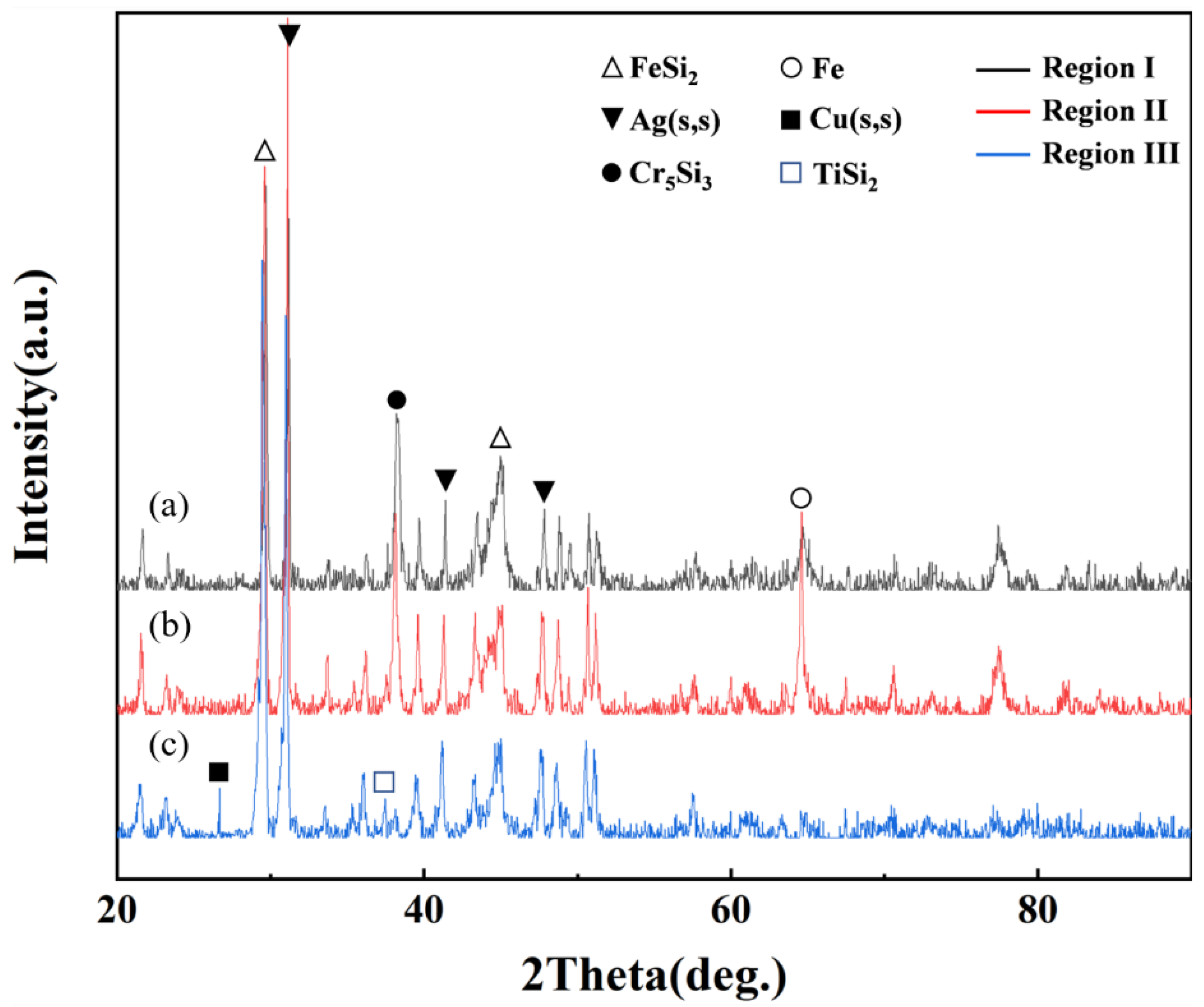
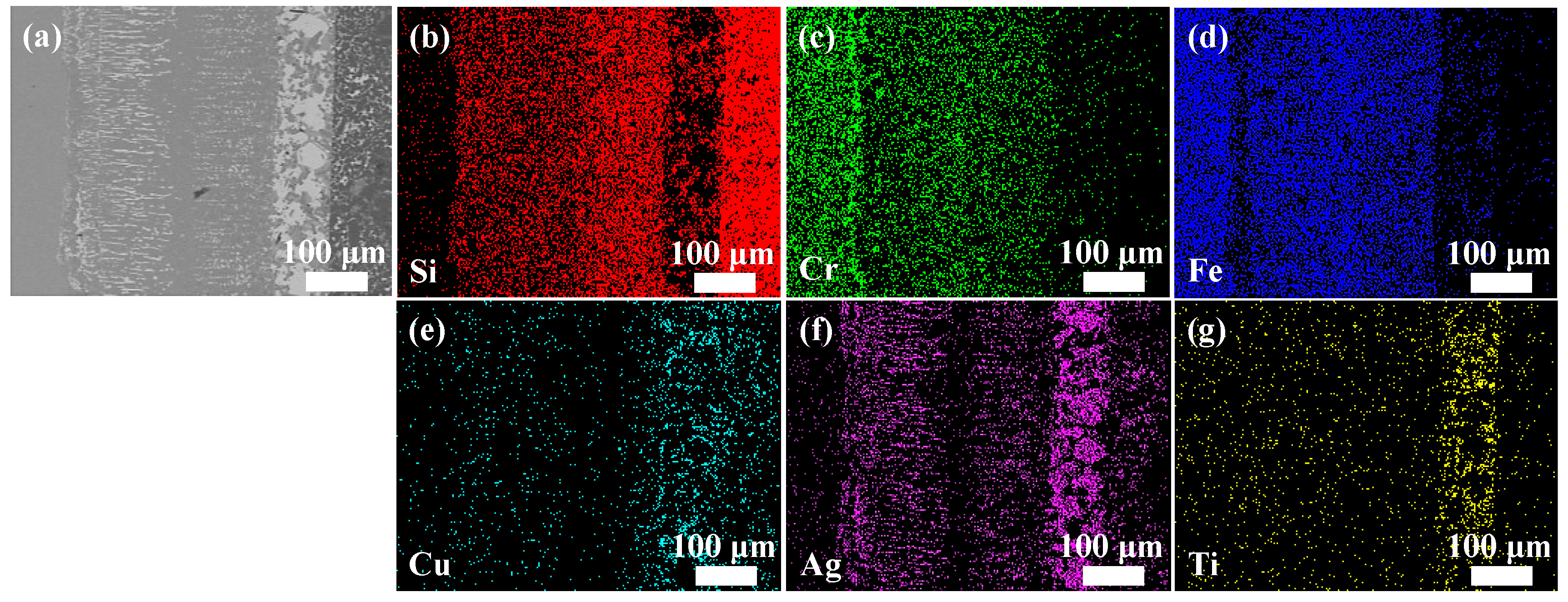
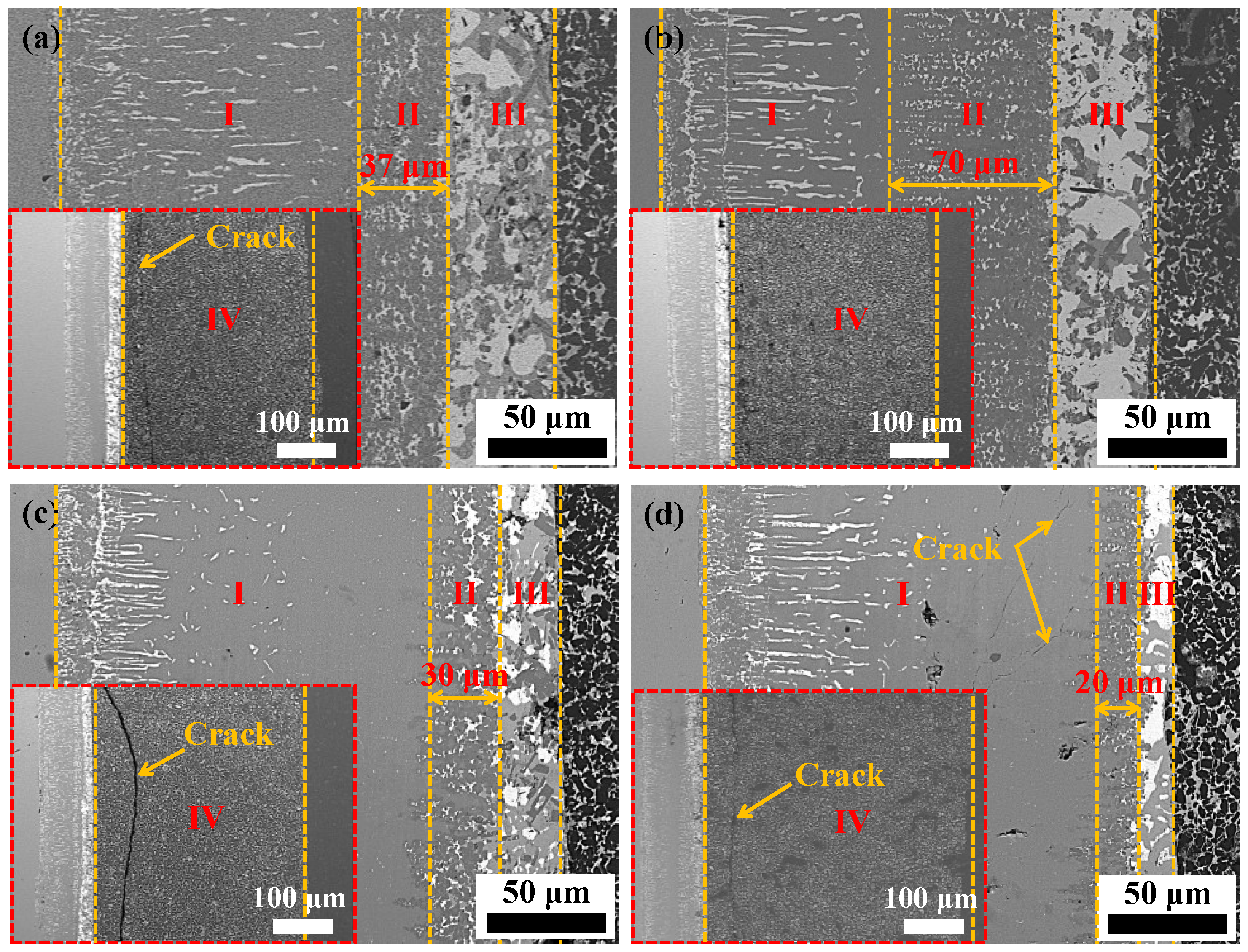

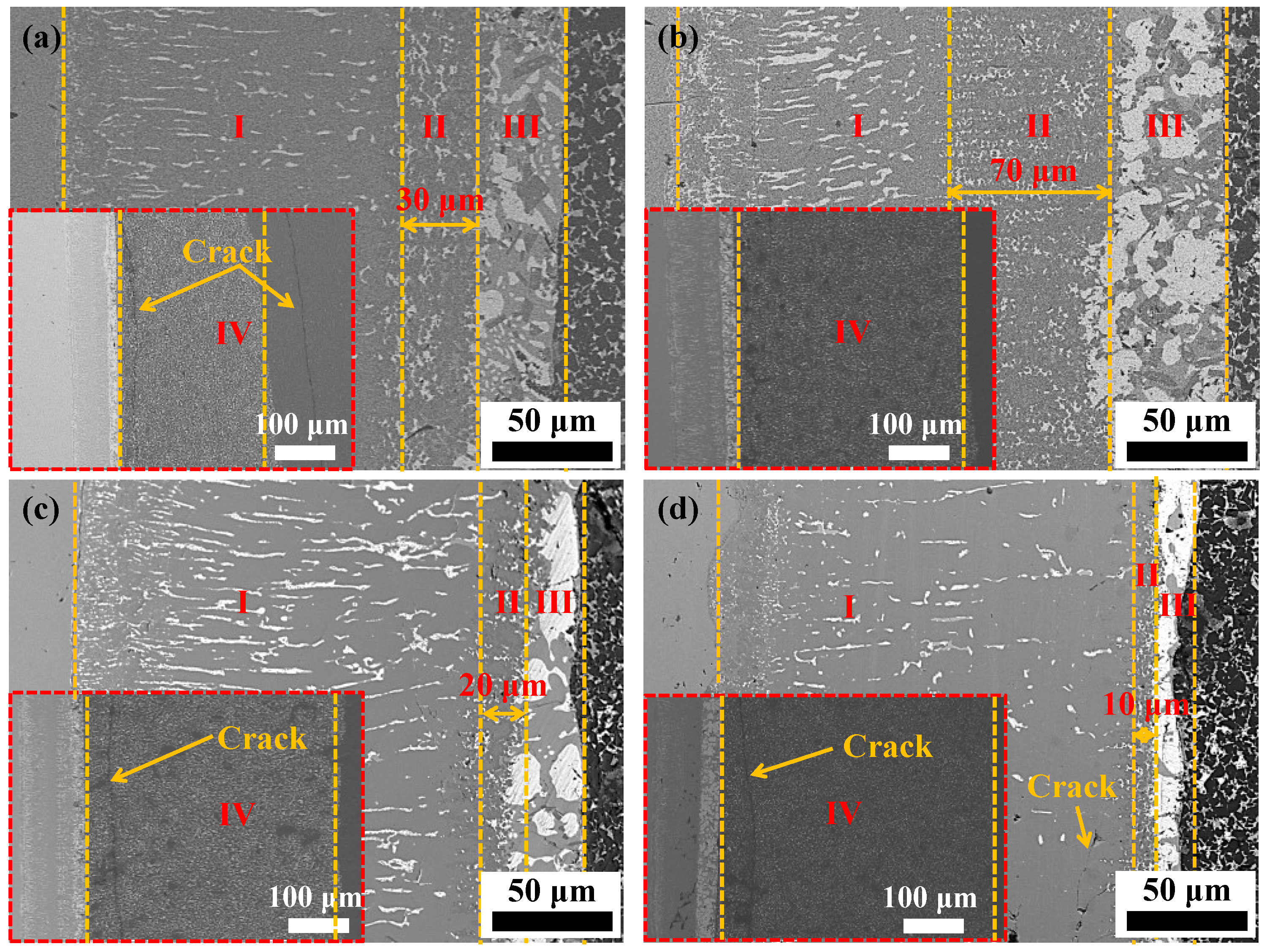
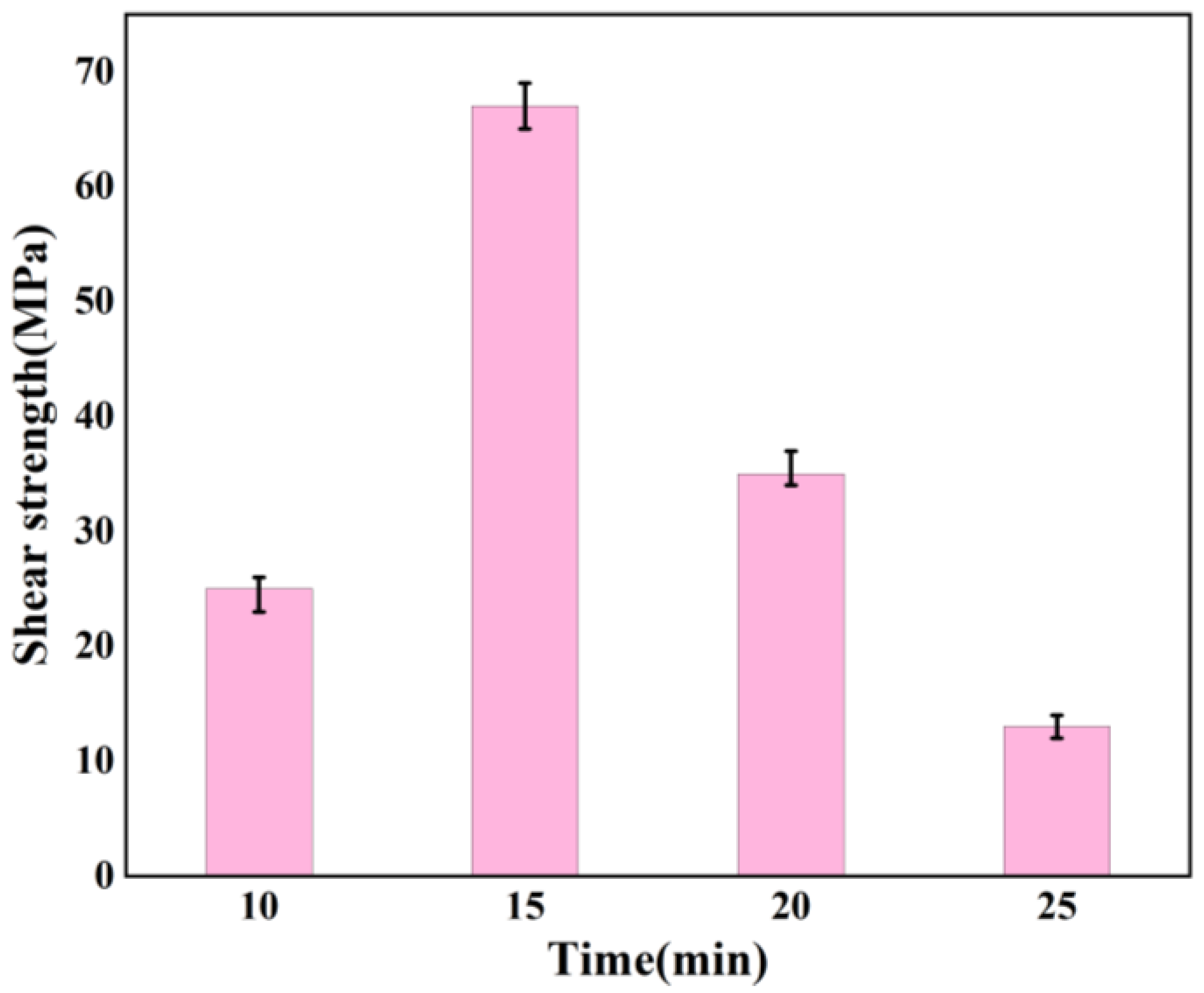
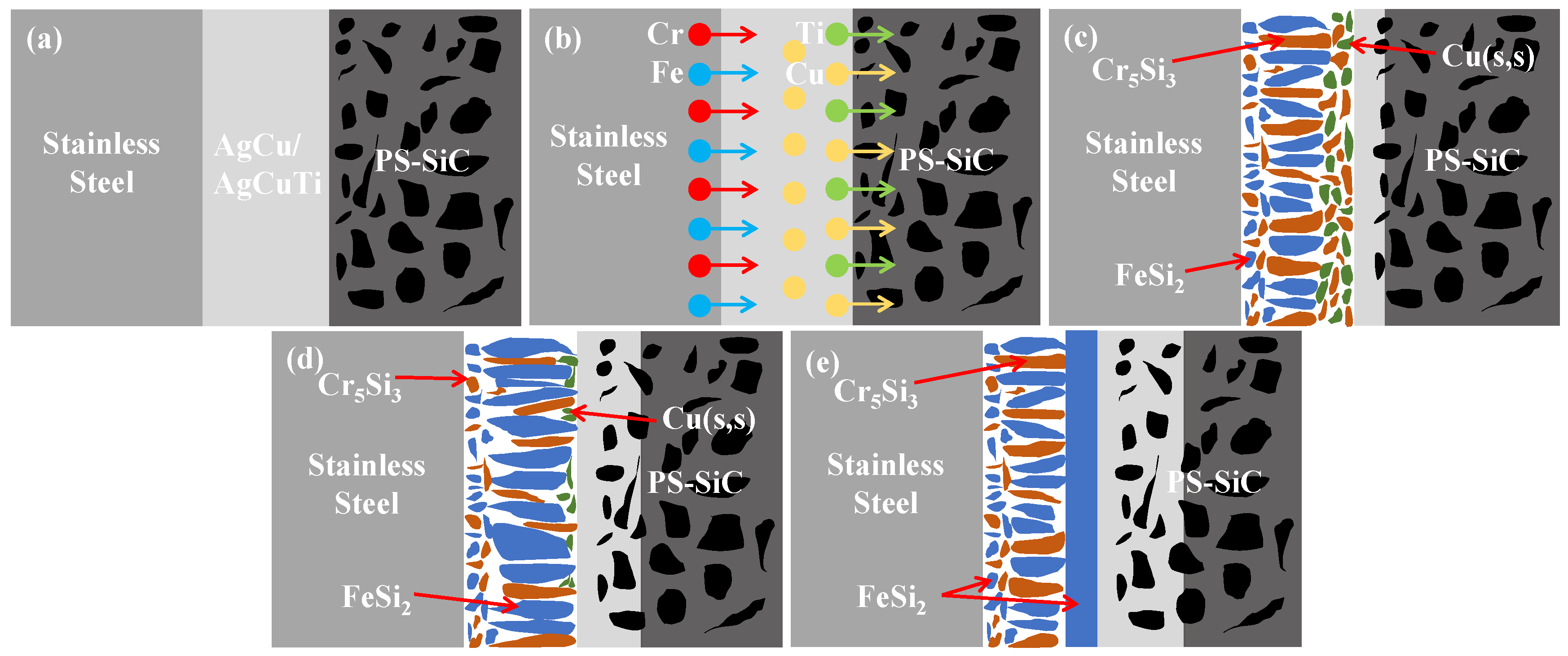
| Model | C | Mn | P | S | Si | Cr | Ni | N |
|---|---|---|---|---|---|---|---|---|
| 06Cr19Ni10 | 0.08 | 2 | 0.035 | 0.015 | 0.75 | 19 | 10 | 0.1 |
| Position | Composition (at.%) | Phase | |||||
|---|---|---|---|---|---|---|---|
| Ag | Cu | Ti | Fe | Cr | Si | ||
| A | 12.59 | 9.30 | 0.28 | 15.05 | 30.88 | 31.90 | Cr5Si3 + FeSi2 |
| B | 6.61 | 9.81 | 6.85 | 23.86 | 1.60 | 51.27 | FeSi2 |
| C | 92.54 | 1.79 | - | 0.24 | 0.47 | 4.96 | Ag(s,s) |
| D | 9.76 | 1.51 | 1.06 | 29.80 | 2.54 | 55.33 | FeSi2 |
| E | - | - | 1.02 | 61.5 | 1.01 | 36.47 | Fe + FeSi2 |
| F | 3.14 | 1.55 | 0.11 | 32.18 | 1.97 | 61.05 | FeSi2 |
| G | 9.76 | 10.54 | 26.80 | 1.51 | 1.56 | 49.83 | TiSi2 |
| H | - | 92.45 | 3.62 | - | 3.53 | 0.40 | Cu(s,s) |
| I | 94.57 | 2.93 | - | 0.39 | 0.51 | 1.60 | Ag(s,s) |
| J | 93.74 | 3.23 | - | 0.28 | 0.36 | 2.39 | Ag(s,s) |
Publisher’s Note: MDPI stays neutral with regard to jurisdictional claims in published maps and institutional affiliations. |
© 2022 by the authors. Licensee MDPI, Basel, Switzerland. This article is an open access article distributed under the terms and conditions of the Creative Commons Attribution (CC BY) license (https://creativecommons.org/licenses/by/4.0/).
Share and Cite
Ma, Q.; Li, S.; Chen, Y.; Pu, J.; He, P. Interfacial Microstructure and Mechanical Properties of Pressureless Sintered SiC Ceramic and Stainless Steel Joints Brazed by AgCu/AgCuTi Alloy. Crystals 2022, 12, 1574. https://doi.org/10.3390/cryst12111574
Ma Q, Li S, Chen Y, Pu J, He P. Interfacial Microstructure and Mechanical Properties of Pressureless Sintered SiC Ceramic and Stainless Steel Joints Brazed by AgCu/AgCuTi Alloy. Crystals. 2022; 12(11):1574. https://doi.org/10.3390/cryst12111574
Chicago/Turabian StyleMa, Qiang, Shengguo Li, Yongwei Chen, Juan Pu, and Peng He. 2022. "Interfacial Microstructure and Mechanical Properties of Pressureless Sintered SiC Ceramic and Stainless Steel Joints Brazed by AgCu/AgCuTi Alloy" Crystals 12, no. 11: 1574. https://doi.org/10.3390/cryst12111574





